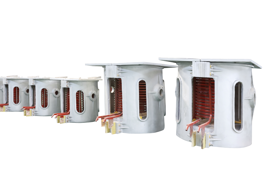Continuous Billet Rolling Production Line Work Process
In lots of steel plants, the continuous billet rolling production line is the key equipment. It combines the continuous casting machine and the rolling mills to produce various types of steel products.

Billet Continuous Rolling Production Line Production Process
During the casting process, the casting temperature, casting speed and cooling water temperature restrict the quality of the billet. The temperature is too high or too low when the liquid steel comes out of the furnace, which is one of the reasons for the porosity and shrinkage cavity of the billet. Therefore, we should strictly control the temperature of molten steel when it comes out of the furnace.
After crystallization, if the temperature of the sheared ingot drops too much, it needs to be heated with a medium frequency induction heating furnace. A temperature measuring point is set at the entrance of the induction heating furnace to monitor the temperature of the steel billet. We can adjust the cooling water temperature and water volume according to this temperature.
Continuously hot-rolled steel billet have high plasticity and low deformation resistance, so larger deformation can be obtained with less energy. In rolling, the rolling temperature, the rolling speed of the continuous rolling mill, and the process lubrication are the three major elements to ensure the quality of aluminum rods. If the rolling temperature is too high, the low-melting-point structure inside the billet will melt, resulting in overheating of the rolled piece, resulting in high-temperature brittle cracks; if the rolling temperature is too low, the billet will be difficult to deform and easily cause rod blocking.

Key Points of Layout of Billet Continuous Rolling Production Line
According to the quantity setting of the power supply, it is determined to use four induction furnaces (two for use and two for standby). Two sets of each set are placed between 3 pinch rollers, the distance between the wheels is 2.6 meters, two sets of pinch rollers are installed at the entrance, the distance between the wheels is 1.6 meters, and the roller diameter is about 200mm.
Internal space: the steel billet is 150×150 square billet. The inside of the sensor is also a rounded square hole with a size of 280×280. The thickness of the refractory material inside the induction heating furnace is 20mm. The net space between billet and refractory material is 45mm.
Advantages of Billet Continuous Rolling Production Line
Large Production Capacity
The operating efficiency of the billet continuous rolling production line has been significantly improved, and the production capacity has been fully increased to overcome the shortcomings of multiple deceleration, shutdown, and reverse rolling.
High Yield
The continuous rolling unit rolls the entire steel coil from the beginning to the end, including the weld bead of the front and rear coils, under the action of the automatic thickness control system to ensure the yield. Improve the target tolerance control of the reversing rolling mill at the head and tail rolling, and increase the strip yield.
Low Energy Consumption
Compared with the single-machine reversible unit, the continuous rolling mill unit saves the configuration of multiple high-power unwinding and unwinding coilers, and the power consumption is greatly reduced. Save the user’s input cost and operating cost to the greatest extent, and the steel loss per ton is reduced to 25% of the reversible unit.

With the continuous expansion of modern industry’s demand for special steel and high-quality steel, and the rapid development of continuous steel casting technology, there are higher requirements for continuous casting technology. The continuous steel casting process plays a key role in the process from raw material to finished product. The pros and cons of the continuous casting process directly affect the quality and performance of steel products and the economic benefits of the enterprise.

